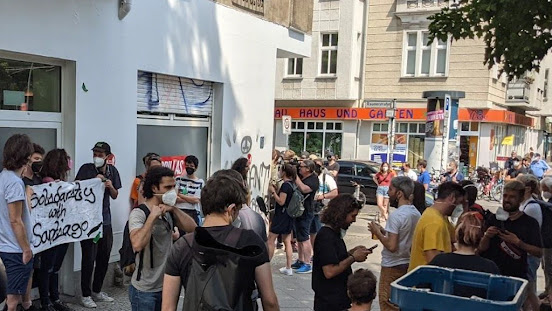The places and flows of labour: essential work, fragmented life-worlds, constrained mobilities
Call-for-contributions to an edited volume
Photo: Andrew Bulkeley, Berliner Zeitung, 10 June 2021, on Gorillas' employees strike/blockade.
At this year's AAG-Conference, Peter V. Hall, Nicolas Raimbault and I organised two sessions on the above subject matter. As a follow-up, we decided to plan for a book publication that puts together some of these and other contributions on how work and labour regimes are changing, due to the emergence of extended (im-)mobilities and the exploitation of human workforce -- with regards to COVID-19 and related frictions for the flow of people or commodities, concerning the notion of 'essential' work, and also in more general terms. See our announcement and details below. M.H.
The COVID-19 pandemic has made more visible the importance of, as well as the difficulties faced by, so-called “essential workers” (Sparke & Anguelov, 2020, 3). The notion of essential work, which defies precise definition, covers a wide range of working conditions, from formal and full-time employment to temporary, contingent and precarious work, to self-employment. Alongside personal care, health and social service work, it includes manual work, mainly blue-collar, in processing activities (construction, manufacturing, food and agriculture) or in the physical distribution of goods (warehousing, transport, deliveries). Those doing work that is essential to the daily lives of others also include employees in direct consumer services (clerks, re-stockers).
Typically, essential workers cannot perform tasks remotely from home, and so they must com-mute. Their workplaces are often scattered across space, from urban centres to suburban peripheries and beyond; in public and private locations; and in a huge variety of old industrial and new logistical lands. The pandemic has thus underlined the diversity and the fragmentation of contemporary working-class spaces (Rose-Redwood et al., 2020, 3).
While the pandemic has revealed the tip of the essential worker iceberg, these jobs and employment conditions have been subject to significant change for a while now. From the decline of the manufacturing sector to the rise of the service sector and from casualization to the rise of the gig economy (Srnicek, 2017), which stand in clear and sharp contrast with the imaginaries and the political power once attributed to the Keynesian blue-collar middle-class (De Lara, 2018).
This edited volume seeks to engage in conversations in geography and the social sciences more broadly on essential work and the new services precariat (Strauss, 2020). The book offers an opportunity to discuss the urban policy ramifications of these processes on the ongoing re-conversion of industrial lands, brownfield sites and waterfront areas which create spaces of affluence and exclusion, and on the related pressures on working-class peoples and communities, as well as public transport and transit-oriented development.
In this context, we are seeking contributions that explore the changing geographies and mobilities of essential workers, urban-regional divisions of labour, as well as the organisation of work-places and its relation to spaces of social reproduction. We seek to explore life-worlds that have come under increasing pressure from contingent employment conditions and globally financialized housing markets. We aim to connect analyses of essential workers and working-class communities with an understanding of the production of the different spaces and localities in which they are embedded, given the fragmented nature of city regions. Contributions may address work that has specific commuting and other mobility requirements; work in mobile sectors (for example delivery and logistics); as well as the residential locations that can be afforded (or not) by working-class people.
Here is a sampling of topics that might be addressed in chapter contributions, but please do not feel constrained to these examples:
- The transformations of working-class labour markets and workforces and the dynamics of the contingent employment.
- The nexus of precarious work, precarious livelihoods and mobility inequality.
- The implications of racialized and gendered identities and social relations at work, at home, in community and while mobile.
- The case of the delivery workers both linked to digital platforms (such as UBER, Deliveroo) and also in logistics and freight distribution (such as Amazon).
- The production of current workplaces, from mixed-used buildings in the context of ur-ban redevelopment projects to scattered warehouses or specialized industrial parks.
- The urban condition of working-class communities, considering residential as well as mobility inequalities, and the emergence of transit deserts.
- (De)Unionization dynamics and strategies, the engagement of working-class communities in urban politics, and the articulation of space and work in current urban and labour struggles.
We are in touch with academic publishers. We are aware of the publication pressures facing early-career scholars, and so when finalizing the choice of publisher, we will ensure that single chapters are included in databases such as Scopus and can be tracked digitally (DOI), so the publication provides a visible and relevant outcome for contributors.
Our schedule is as follows:
- Submission of abstracts until 31st August 2021
- Notification of authors and submitting official book proposal by 30th September 2021
- Submission of 1st draft chapters by 28th February 2022
- Response to authors by 31st March 2022
- Submission of 2nd draft chapters by 31st May 2022.
Please send your abstracts of up to 250 words by 31st August 2021 to Peter V. Hall (pvhall@sfu.ca), Markus Hesse (markus.hesse@uni.lu) and Nicolas Raimbault (nicolas.raimbault@univ-nantes.fr). Feel free to ask any questions you might have.
References
De Lara, J. (2018). Inland shift: Race, space, and capital in Southern California. Los Angeles, University of California Press.
Korsu, E., & Wenglenski, S. (2010). Job accessibility, residential segregation and risk of long-term unemployment in the Paris region. Urban Studies, 47(11)
Sparke, M., & Anguelov, D. (2020). Contextualising coronavirus geographically. Transactions of the Institute of British Geographers. DOI: 10.1111/tran.12389
Srnicek N. (2017), Platform capitalism. Cambridge, Polity Press.
Strauss, K. (2020). Labour geography III: Precarity, racial capitalisms and infrastructure. Progress in Human Geography, 44(6), 1212-1224.
Rose-Redwood, R., Kitchin, R., Apostolopoulou, E., Rickards, L., Blackman, T., Crampton, J., ... & Buckley, M. (2020). Geographies of the COVID-19 pandemic. Dialogues in Human Geography, 10(2), 97-106.















